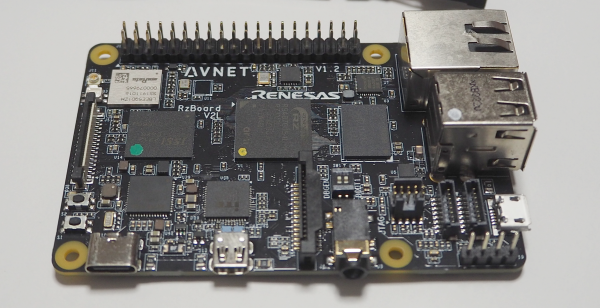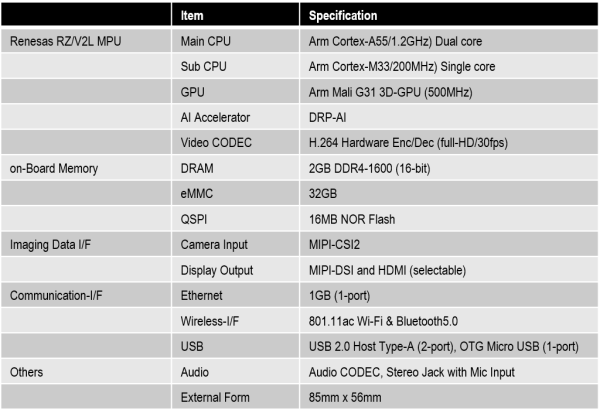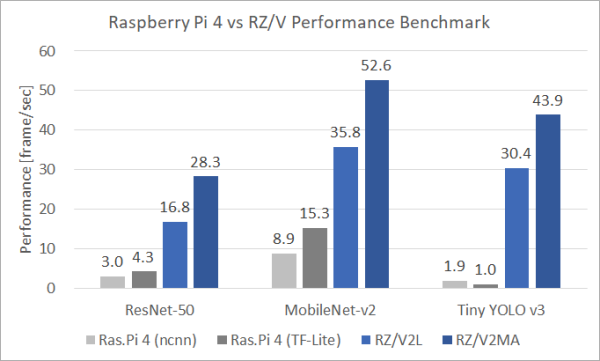Introduction
Never before has the word "semiconductor" been so much in the public eye.
Last year, the supply shortage of semiconductors was covered in various media. Many people realized that the various electronic devices we have been using and taking for granted until now were all supported by small parts called semiconductors.
Initially, this very small computer invented to make calculator design more flexible, has improved its function and performance exponentially. Encouraged by Moore's Law, the essence of the semiconductor business, has become a fundamental component of social systems.
In this blog, I would like to introduce the RZ Family, a high-end embedded MPU manufactured by Renesas Electronics that has reached the peak of the evolution of such microcomputers, and the RZBOARD V2L, a Raspberry Pi-type board equipped with this MPU.
RZ/V2L, the latest embedded AI processor in the RZ family
Renesas Electronics offers many microcontrollers, of which the RZ family is the high-end product. A conventional microcontroller can be operated on a single chip with built-in Flash ROM and SRAM. However, due to limitations in the manufacturing process of semiconductors, microcontrollers with built-in Flash ROM have a problem. Which is the difficulty when increasing the operating frequency. For example, the RX family, Renesas' representative 32-bit microcontrollers, has a maximum operating frequency of 240MHz, even for the top-of-the-line RX700 series.
In contrast, the RZ family is a newer generation of embedded processors that does not incorporate Flash ROM and uses a state-of-the-art process that significantly improves performance.
One of the RZ family MPUs, the RZ/V2L AI processor, is equipped with two Cortex®-A55, the latest 64-bit CPU core from Arm®, and can run at 1.2GHz, a much higher operating frequency than MCUs.
And, the RZBOARD V2L, a Raspberry Pi-type single-board computer equipped with RZ/V2L, was released this summer.
RZBOARD V2L Specifications
Let's check out what this RZBOARD V2L board looks like. Its appearance is shown in Figure 1, and a specification summary is shown in Figure 2.
Form Factor
It has the same size as Raspberry Pi 3 and 4 (85mm x 56mm) and the layout of each terminal is similar to Raspberry Pi 4, but due to differences in specifications, USB 2.0 (Type-A x2) is replaced by a Micro USB connector and the two, Micro HDMI terminals are reduced to one. The USB Type-C terminal used for power, the MIPI-CSI terminal for camera input, and the MIPI-DSI terminal for display output are connectors with the same specifications and are located in the same position as the Raspberry Pi.
CPU and AI Processor
Compared to the quad-core Raspi3 Model B+ (Cortex-A53/1.4GHz x4) and Raspi4 (Cortex-A72/1.5GHz x4), the CPU configuration may appear to be less powerful, but instead it has a powerful AI accelerator DRP-AI, which is its greatest feature. This AI accelerator is based on Renesas' proprietary Dynamically Reconfigurable Processor (DRP) extended for AI. For example, when running the object recognition model TinyYOLOv3, the AI performance can be 16 times higher than Raspi4 (*1).
Furthermore, DRP-AI has the AI performance equivalent to a low-end GPU at 1/3 the power consumption of a GPU and does not require any heat-dissipating components such as cooling fans, which are essential for Raspi 4.
(※1) Raspberry Pi4 (ncnn): 1.9fps, RZ/V2L (DRP-AI Translator): 32.9ms (30fps)GPU
Arm's entry-level GPU Mali-G31 is installed on-chip. Even though it is an entry-level GPU, it is a 3D-capable GPU, so it can handle light graphics display.
Video Processing
As with the Raspberry Pi, the MIPI-CSI2 camera input is provided. The input resolution can be up to 5M-pixel, so it is possible to capture more than full-HD (2M-pixel) depending on the camera module.
An H.264 codec for full-HD (1920x1080)/30fps is also included, so that, for example, Full-HD video captured by the camera module can be encoded in real time, stored on an SD card, and transmitted to a host device over Ethernet. Media processing can be done with a single chip.Other I/Os
Ethernet is Gbps-capable, and there are two USB 2.0 channels. The onboard CAN, which is not available on the Raspberry Pi, may be of interest to those who are considering applications in industrial equipment.
Memory
There is 2GB (x16 configuration) of DDR4-DRAM onboard and 32GB of eMMC. There is also a MicroSD slot on the back that can be used as storage.
AI Performance Benchmark
Finally, here are the benchmark results for the Raspberry Pi 4 and RZ/V2L.
Figure 3 shows a graph comparing the inference performance of the Raspberry Pi 4 with the RZ/V2L and the RZ/V2MA, a higher-end model of the V2L, for three different AI models. The performance of Raspberry Pi 4 on two AI frameworks, ncnn, and TensorFlow Lite, comes from the Q-engineering website (*2).
Although there are differences between the AI models, for example, in the case of TinyYOLOv3, RZ/V2L shows performance as high as 16 times higher than Raspberry Pi 4 (ncnn).
(*2) Deep learning with Raspberry Pi and alternatives in 2023 (web)
This blog introduced the RZBOARD V2L, a raspy-like evaluation board that can run AI with extremely high power efficiency compared to conventional processors and GPUs. By making it possible to easily test the high power performance of DRP-AI with RZBOARD V2L, I expect that vision AI will be applied to various applications that have been difficult to adopt due to power constraints, heat generation, and cost issues.
References
RZ/V2L Group User's Manual: Hardware (R01UH0936EJ0140)
RZ/V2L, RZ/V2M, RZ/V2MA DRP-AI PERFORMANCE REPORT (R11AN0657EJ0740)
RZBoard V2L Hardware User Guide (v1.0 October 05, 2022)
RZBoard V2L Quick-Start Guide (v1.1)
White Paper: Embedded AI Accelerator (DRP-AI)
Trademarks
Arm and Cortex are registered trademarks of Arm Limited (or its subsidiaries) in the EU or other countries.



